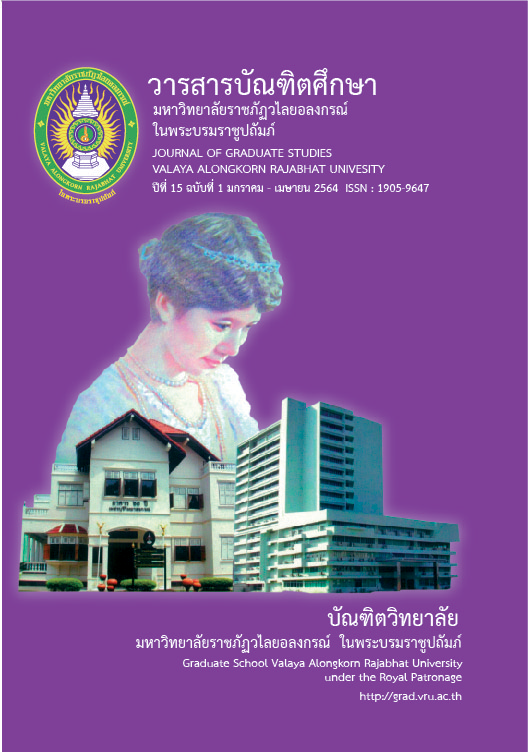PROMOTING OF MUSEUM TOURISM IN THAILAND WITH THE CONCEPT OF DESTINATION MUSEUM
Main Article Content
Abstract
This research aimed to 1) study the components of tourism focusing on destination museums, 2) examine the roles and responsibilities of the stakeholders for museum tourism, and 3) suggest guidelines to promote museum-based tourism under the destination museum concept. The qualitative research employed an in-depth interview with 74 participants who were involved in museum tourism.
The results to showed that 1) Study the elements of museum tourism destination results were the definition of a museum from the supply part focused on museums offering learning experiences, which included the conservation of cultural heritage. In tourists ‘viewpoints, an additional definition was that a museum was a place of learning and recreation. The results from the analysis based on the framework of museum tourism found that there were eight components to enhance museum tourism. These comprised exhibitions organized at a museum, technological innovations, museum tourism activities, facilities and services provided by the museum. Logistics and transport system management, souvenir shops, guides or interpreters, and accommodation businesses around a museum as a part of the tourism promotion. 2)Study the roles and responsibilities of stakeholders museum tourism destination results were interaction and collaborative work among the stakeholders of museums and tourism were essential to construct the network of museum tourism. and 3) Guidelines for promoting museum tourism in Thailand with the concept of museum destination results were presented five themes of guidelines for museum tourism promotion: 1) Designing activities at a museum by emphasizing fun, 2) Effective human resource management, 3) Designing the landscape on services and providing tourists with services at the museum, 4) Identifying the construction and cultural management for the museum, and 5) conveying learning experiences that could connect to the present lifestyle.
Article Details

This work is licensed under a Creative Commons Attribution-NonCommercial-NoDerivatives 4.0 International License.
บทความทุกเรื่องได้รับการตรวจความถูกต้องทางวิชาการโดยผู้ทรงคุณวุฒิ ทรรศนะและข้อคิดเห็นในบทความ Journal of Global of Perspectives in Humanities and Social Sciences (J-GPHSS) มิใช่เป็นทรรศนะและความคิดของผู้จัดทำจึงมิใช่ความรับผิดชอบของบัณฑิตวิทยาลัย มหาวิทยาลัยราชภัฏวไลยอลงกรณ์ ในพระบรมราชูปถัมภ์ กองบรรณาธิการไม่สงวนสิทธิ์การคัดลอก แต่ให้อ้างอิงแหล่งที่มา
References
Atraksa, I. (2015). kānphatthanā rūpbǣp phiphitthaphan theknōlōyī khō̜mphiutœ̄ samư̄an čhing [A Development of a Virtual Museum ModeL on Computer Technology]. Journal of Humanities and Social Sciences, Srinakharinwirot University. 8(2), 275-284.
Bryant, J. (1988). The Principles of Marketing, a Guide for Museums, Chichester: Association of Independent Museums Guideline 16.
Bramwell, B. & Sharman, A. (1999). Collaboration in local tourism policymaking. Annals of tourism research. 26(2), 392-415.
Dallen, J. T. & Stephen, W. B. (2003). Heritage Tourism. London: Prentice Hall.
Daskalaki, V. V., Voutsa, M. C., Boutsouki, C. & Hatzithomas, L. (2020). Service quality, visitor satisfaction and future behavior in the museum sector. Journal of Tourism, Heritage & Services Marketing. 6(1), 3-8.
Dolak, J. (2017). Some remarks toward the ICOM museum definition. Museum. (6), 6.
Falk, J. H. & Dierking, L. D. (2013). The museum experience revisited. Walnut Creek.
Gilmore, A. & Rentschler, R. (2002). Changes in museum management. Journal of management development. 21(10), 745-760.
Goffman, E. (2002). The presentation of self in everyday life. 1959. Garden City, NY.
Haas, J. (2003). The changing role of the curator. Fieldiana. Anthropology. (36), 237-242.
Hausmann, A. (2012). The importance of word of mouth for museums: An analytical framework. International Journal of Arts Management. 14(3), 32.
Hein, G. E. (2002). Learning in the Museum. routledge.
Hovinen, G. R. (2002). Revisiting the destination lifecycle model. Annals of tourism research. 29(1), 209-230.
Hume, M. (2015).To technovate or not to technovate? Examining the inter-relationship of consumer technology, museum service quality, museum value, and repurchase intent. Journal of Nonprofit & Public Sector Marketing. 27(2), 155-182.
Ing, D. S. (1999). Innovations in a technology museum. IEEE Micro. 19(6), 44-52.
Krakowiak, B. (2013). Museums in cultural tourism in Poland. Turyzm. 23(2), 23-32.
Lambert, S. & Henderson, J. (2011). The carbon footprint of museum loans: a pilot study at Amgueddfa Cymru–National Museum Wales. Museum Management and Curatorship. 26(3), 209-235.
Leiper, N. (1999). Visitor management. Annals of Tourism Research. 26(3), 731-733.
MacCannell, D. (1989). Staged Authenticity: Arrangements of Social Space in Tourist Settings. American Journal of Sociology. 79(3), 589-603.
McCarthy. (2019). These are the world's most-visited museums. Retrieved from https://www.weforum.org/agenda/2019/05/the-worlds-most-visited-museums
Mendiratta, A. (2010), PPP– Partnering for tourism growth, COMPASS – Insights into Tourism Branding, 1-7.
Miles, M. B. & Huberman, M. A., (1994). Qualitative data analysis: An expanded sourcebook (2nd ed.), Sage Publications Inc., Thousand Oaks, CA.
Mill, R. C. & Morrison, A. M. (2002). The Tourism System. Kendall. Hunt, Dubuque, Iowa.
Nechita, F. (2014). The new concepts shaping the marketing communication strategies of museums. Bulletin of the Transilvania University of Braşov, Series VII: Social Sciences and Law. (1), 269-278.
Nowacki, M. M. (2005). Evaluating a museum as a tourist product using the servqual method. Museum Management and Curatorship. 20(3), 235-250.
Nukong, A. (2016). kānčhatkān phiphitthaphan yāng sāngsan phư̄a kānthō̜ngthīeo thāng watthanatham nai čhangwat Phuket [Creative Museums Management for Cultural Tourism in Phuket Province]. Inthaninthaksin Journal, Thaksin University. 10(2), 179-197.
Park, H. Y. (2013). Heritage tourism. Routledge.
Plaza, B. (2000). Evaluating the influence of a large cultural artifact in the attraction of tourism: the Guggenheim Museum Bilbao Case Study. Urban Affairs Review. 36(2), 264-274.
Prentice, R. (2001). Experiential cultural tourism: Museums & the marketing of the new romanticism of evoked authenticity. Museum Management and curatorship. 19(1), 5-26.
Proctor, N. (2010). Digital: Museum as platform, curator as champion, in the age of social media. Curator: The Museum Journal. 53(1), 35-43.
Prosser, G. & Hunt, S. (2000). Regional Tourism Research: a scoping study. Centre for Regional Tourism Research.
Richards, G. & Wilson, J. (2006). Developing creativity in tourist experiences: A solution to the serial reproduction of culture. Tourism management. 27(6), 1209-1223.
Silberberg, T. (1995). Cultural tourism and business opportunities for museums and heritage sites. Tourism management. 16(5), 361-365.
Swarbrooke, J. (1999). Sustainable Tourism Management. Oxford: CABI.
World Tourism Organization. (1993). Sustainable Tourism Development: Lessons for Planners WTO, Madrid.


